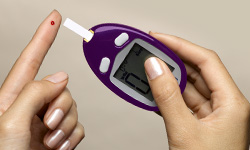Whether you are gardening on a hot summer day or exercising even at moderate intensity, dehydration can creep up on everyone…not just athletes. Daily average fluid loss in sedentary adults ranges from 2-3 liters per day. Athletes who train 2 hours per day can easily lose an additional 2 liters resulting in a total fluid loss of up to 5 liters per day.
Dehydration increases your core temperature causing cardiovascular strain in the form of increased heart rate, increased blood pressure and lower cardiac output (the volume of blood pumped by the heart in one minute). Outward signs of dehydration are obvious thirst, muscle cramps, weakness, decreased athletic performance, difficulty with focus, headache, nausea, fatigue, reduced urine output, dark urine and dizziness. In athletes, even 4% dehydration can result in 20-30% decrease in work performance. The problem with these “warning signs” is that they are not truly a “warning” at all. By the time you experience these symptoms, dehydration has already occurred.
If you are dehydrated going into a physical activity, no amount of water you drink during the activity is going to make up for not drinking enough water on a daily basis. Voluntary fluid intake during physical activity usually replaces only 50% of the sweat loss.
Most mineral losses in sweat are minor. A good diet and general supplementation with a multi-vitamin and mineral supplement will do the job. If you are not sure where you stand with regard to mineral status, getting tested will help you fine tune your regime. Sodium and chloride losses however, can be significant. Marathon runners performing in heated conditions can lose up to 10 grams of sodium in one event. Losses of sodium and chloride through sweat have been associated with muscle cramps and fatigue. It is rarely necessary to supplement potassium because of fluid loss via sweat. Although salt supplementation is usually not necessary, if you are on a self imposed salt restrictive diet, you may need to supplement ¼ – ½ teaspoon of iodized sea salt to recover from sodium and chloride losses through sweat. A nutritional consultation will help you determine your mineral and electrolyte needs.
To avoid dehydration, drink water before you feel thirsty. General recommendations for adults is 1 quart per 50lbs of body weight and don’t go over 3 quarts. You need enough water per day to urinate every 2-4 hours. Normal urine color should be pale yellow. Be aware that medications (especially diuretics), caffeine and alcohol consumption will increase your fluid needs.
Exercise requirements: 2 hours prior to exercise drink 16-24 ounces of water; 15 minutes prior to exercise drink 3-6oz.; During exercise drink 4-6oz for every 15-20 minutes.
Recovery after exercise: measure yourself before and after exercise to determine your individual needs. It is recommended you drink water until your pre-workout weight is attained (generally 16oz of water per pound of body weight lost).
Your blood and other fluids help to remove waste products and to bring nutrients to tissues for repair. Replacing lost fluids as quickly as possible after a workout or a day of heavy gardening will speed up your recovery.
What about Sport Drinks and other beverages?
The average Joe’s workout does not need a sport drink for rehydration unless you’re a serious athlete and the duration of your workout is over 60 minutes. Many of the “enhanced” waters and sport drinks contain additional calories and sugars that “average” exercisers do not need. We would rather those “extra” calories come from fresh fruits and vegetables. Water is sufficient for their workouts along with a proper diet.
For high intensity, hot climate or long duration workouts, when choosing a sport drink or enhanced beverage, the fluid should contain some carbohydrate (not too much) and some sodium chloride. The carbohydrate helps to maintain training intensity because it is the primary energy fuel used during exercise events. Sodium chloride is necessary not for replacement of lost levels rather it helps to stimulate water uptake and retention as well as carbohydrate uptake.
What kind of carbohydrate?
In general, you want to look for combinations of sucrose, glucose, and fructose sugars. In fact, they are most effective when they are consumed as a combination. Studies have shown that combining the different carbohydrates helps athlete’s burn 55% more carbohydrates than those with glucose solution only. In addition, you want to take a look at the ingredient list to determine the source of the sucrose, glucose and fructose. Less refined sources would be fruit juice, honey, or evaporated cane juice. Ask yourself, “Are there any artificial sweeteners?”. Although “reduced calorie”, artificial sweeteners have never been shown to help anyone lose weight. Many top selling sport drinks contain only high fructose corn syrup and artificial sweeteners. Drinking more than 60 grams of fructose will inhibit performance and result in diarrhea.
Some may think juice to be nutritious, but it isn’t the best choice for hydration. Juice is primarily fructose and as explained above can reduce the rate of water absorption so cells don’t get hydrated very quickly.
How much carbohydrate? Both fluid and carbohydrate requirements can be met by consuming 20-40oz per hour of beverages containing 4-8% carbohydrate. This works out to about 36 grams of carbohydrate in 20-40oz.
For the average exerciser, if you’re tired of water a simple electrolyte powder might be beneficial. You won’t necessarily need any carbohydrate content, so keep your eye out for electrolyte powders that are easy to carry in your gym back and can simply be added to your own water. If you think you might need a little extra energy to get you through a particularly tough workout, try a honey stick. Honey sticks are equal parts sucrose and fructose. Sucrose will be absorbed quickly while the fructose portion burns a little slower so your blood glucose doesn’t bottom out. Honey sticks can be purchased at your local health food store.

